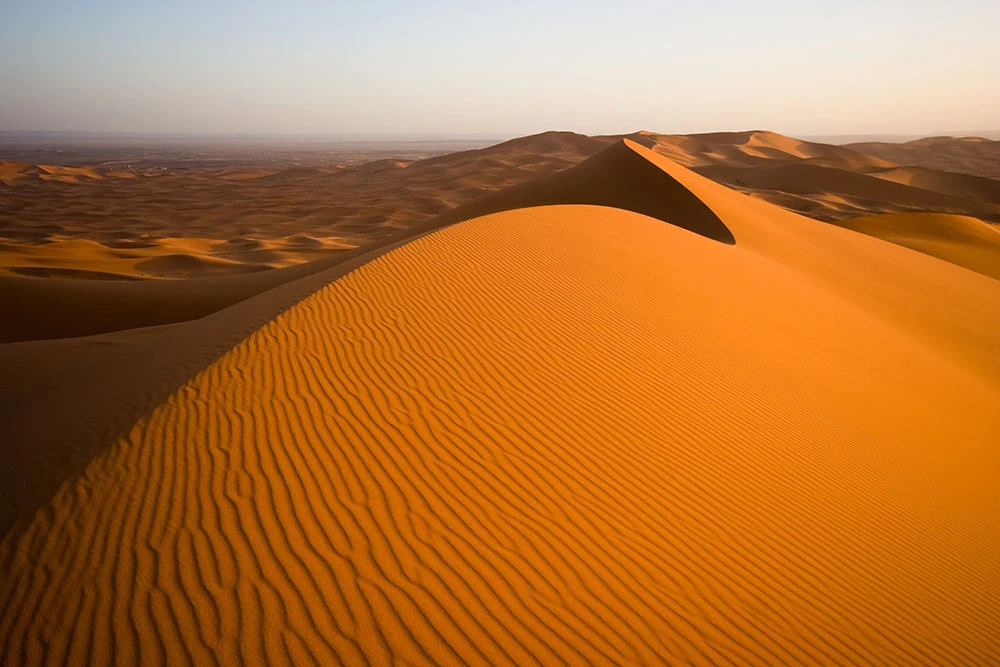The clay from the former shores, hills, and soil of the Cretaceous period look like they are on fire during sunrise and sunset. You may feel like you are on a different planet. Really though, you’re in the Mongolian Gobi Desert.
Dinosaur fossils from millions of years ago still remain here. Most are small and often hidden by Saxaul forests, which are ubiquitous with the Gobi, so you may pass them by without noticing. Desert plants, dry but capable of coming to life in an overnight rain, are also unique to the Gobi.
Though the golden sand won’t remember your steps once the wind blows, the footprint of the Gobi desert will stay in your heart forever.

Nature’s Song of Sand – Khongor sand dunes
The Khongor sand dunes lie from northwest to southeast. The dunes are 27 km at its widest covering 965 square km in total reaching 200 meters (650 feet) in height.
While the southern part of the dunes is rocky and mountainous, the central part is barren with no plants and northern part has several oases. The contrast is amazing. On a windy day, the sand will rise up in a storm and you won’t see anything around you, but on a calm and sunny day it glows magnificently in the sun. It’s truly one of Mother Nature’s wondrous creations.
The widest section of the Khongor is nicknamed the singing dunes, because when you climb them (which is a challenging hike), the sand will squeak under your feet making a singing-like noise. If you lie down in this part of the dunes, you will hear the sound close to that of a plane that is the sound of hot sand scrolling in the wind.

Flaming Cliffs – Bayanzag
This is the place that made the Gobi desert famous all over the world. During the 1920s, a research expedition led by American explorer Roy Chapman Andrews found dinosaur eggs, a rhino-like huge dinosaur skeleton, and a parrot-nosed dinosaur. Famously the explorer happened upon the find when he fell down a cliff.
Bayanzag spreads across 8 km in a valley of the Arts Bogd mountain range. When the sun sets, Bayanzag’s cliffs are breathtaking in their beauty with red clay almost glowing. One might say only gasp, “it’s flaming” – which is how it gets its name.

Dragons Grave – Nemegt Mountain
Nemegt mountain, Altan mountain, Tugrugiin Shiree, Ukhaa Tolgod, and Khermen Tsav are well known places in the global palaeontology science, often hosting international research expeditions.
Nemegt mountain, located 400 km from Dalanzadgad, the capital of South Gobi province, has a flat top from which you can see endless canyons. The main canyon is divided into three sections, all of which will make you feel like you are in another world. Like Bayanzag, this mountain consists of clay. In the 1960s and 70s, Mongolian, Soviet, and Polish scientists conducted research expeditions here and discovered number of world famous findings.
Nemegtzaurus, a predatory dinosaur, was discovered and named after this place. Nemegt valley and Nemegt mountain are called “Dragon’s Grave” by palaeontologists.
Gobi waterfall – Tsagaan Suvarga
Tsagaan Suvarga is a natural formation that looks like ancient city ruins, located in Luus soum of Dundgobi province. Its highest point is 30 meters, and its length is 400 meters. During downpour water flows from its vertical walls, and it looks like a huge waterfall.

Forest of Giant Rocks – Ikh and Baga Gazriin Chuluu
Ikh Gazriin Chuluu, a unique rock formation with a sharp top, and Baga Gazriin Chuluu, a formation that looks like a pile of rocks stretching for 300 square meters, are two beauties of the Dundgobi. These sites are amazing places with shimmering mirages and herds of grazing livestock.
Long song that touches the cosmos
Long songs reflect the nature of Gobi people. By listening to a long song, you will lose yourself in the wind sweeping across the steppe and stillness of the moment.
Note 1: By June 2014, 2,806 special mining permissions were issued in the region, 7.7 per cent of the territory. Companies engaged in mining exploration and extractions have been financially supporting the livelihood of local people and local development.
Note 2: Riding a Bactrian camel, also called as “the ship of the sand dunes” and “living dinosaurs,” is a must-do in the Gobi. Also, the Gobi offers some fun activities like surfing the sand dunes and searching for dinosaur fossils and eggs.
Please visit Mongolia’s official travel page at www.mongolia.travel for more information about tours.



